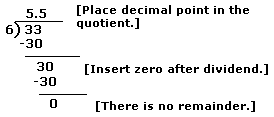Solved Examples and Worksheet for Fractions as Terminating or Repeating Decimals
Step: 1
A decimal that terminates or stops after a finite number of decimal places is a terminating decimal.
Step: 2
Among the choices, except 0.055, all are repeating decimals.
Step: 3
So, 0.055 is a terminating decimal.
Correct Answer is : 0.055
(I)
(II)
(III)
A. Only (I)
B. Only (II)
C. Both (I) and (III)
D. Both (II) and (III)
Step: 1
A fraction can be converted into a decimal by dividing the numerator by the denominator. If the division ends with a remainder of zero, the decimal is called a terminating decimal.
Step: 2
Consider the first fraction, 4 9
4 9
[Convert the fraction into a decimal number.]
Step: 3
Consider the second fraction, 6 5
6 5
[Convert the fraction into a decimal number.]
Step: 4
Consider the third fraction, 6 11
6 11
[Convert the fraction into a decimal number.]
Step: 5
Among the fractions, the second fraction is a terminating decimal.
Correct Answer is : Only (II)
i. 33 ÷ 6
ii.6 ÷ 33
A. (ii)
B. (i)
C. Both (i) and (ii)
D. None of the above
Step: 1
33 ÷ 6
[Divide 33 with 6.]

Step: 2
The quotient obtained after dividing 33 with 6 is 5.5, which is a terminating decimal.
Step: 3
6 ÷ 33
[Divide 6 with 33.]
Step: 4
After dividing 6 with 33, the quotient obtained is 0.181818...
Step: 5
Since 18 is coming repetatively in quotient, 6 ÷ 33 is a repeating decimal.
Step: 6
So, (ii) is a repeating decimal.
Correct Answer is : (ii)
Step: 1
For 1 9
Step: 2
For 4 9
Step: 3
For 4 3
Step: 4
For 5 10
Step: 5
A decimal that terminates or stops after a finite number of decimal places is a terminating decimal.
Step: 6
So, 5 10
Correct Answer is : 5 10
Step: 1
For 1 7
Step: 2
For 1 3
Step: 3
For 2 9
Step: 4
For 1 4
Step: 5
A decimal that terminates or stops after a finite number of decimal places is a terminating decimal.
Step: 6
So, 1 4
Correct Answer is : 1 4
Step: 1
For 2 ÷ 3, the quotient is 0.66666. . . and the digit 6 is repeating.
Step: 2
For 4 ÷ 9, the quotient is 0.44444. . . and the digit 4 is repeating.
Step: 3
For 10 ÷ 3, the quotient is 3.33333. . . and the digit 3 is repeating.
Step: 4
For 5 ÷ 2, the quotient is 2.5.
Step: 5
A decimal that terminates or stops after a finite number of decimal places is a terminating decimal.
Step: 6
So, 5 ÷ 2 is the terminating decimal.
Correct Answer is : 5 ÷ 2
- Converting Fractions and Decimals-Gr 8-Solved Examples
- Classifying Rational and Irrational Numbers-Gr 8-Solved Examples
- Approximating Square Roots of Irrational Numbers-Gr 8-Solved Examples
- Locating Irrational Numbers on a Number Line-Gr 8-Solved Examples
Related Worksheet
- Terminating Decimal